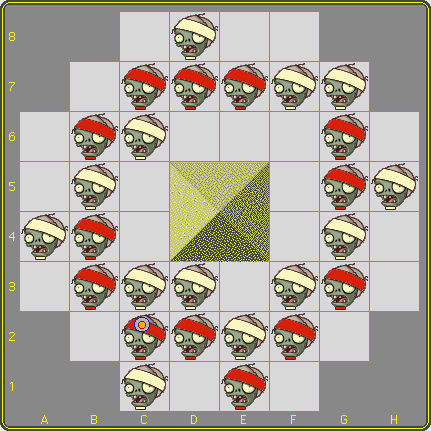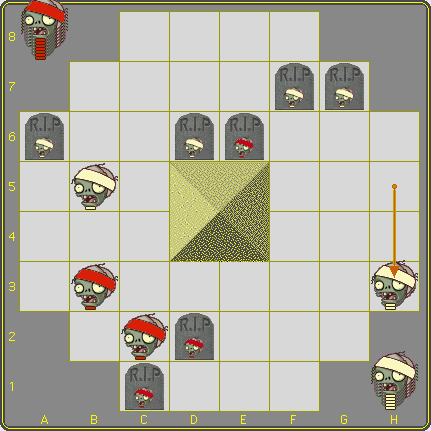There are two zombiemasters, Red and White. Each has a sufficient number of zombies at his disposal. In addition there's a sufficient number of tombstones.
Definitions
- The "capacity" of a grave equals the number of its neighbors.
- Zombies operate in stacked "groups". A single zombie is a group of one. Groups may have any composition and are controlled by the color on top.
- A "tombstone" removes a square and thus reduces the capacity of its neighbors by one.
Rules
The game starts with the dead eagerly waiting to rise from their open graves. There are two stages, the resurrection- and the movement stage.
The resurrection stage
Zombies rise in pairs from adjacent graves, side by side, one of each color. The White master starts by resurrecting one corpse from a grave he chooses. From that point on masters take turns to:
- Resurrect a corpse from a grave next to the corpse just resurrected by the opponent, and ...
- ... resurrect a corpse from a grave that has only open neighbors.
Both resurrections are compulsory. When the master to move can no longer perform the second resurrection, then his turn ends and his opponent may start the movement stage. The number of white and red zombies will always be equal, although the 'density' of the teams may vary and either master may end up being the one to start the next phase, depending on whether the number of full turns was even or odd.
 | Here's a position at the end of the resurrection stage. Red's last move was the placement at C2, White now starts the movement stage. |
The movement stage
On his turn a master must either move one of his groups or enter a zombie.
- A group moves horizontally or vertically, based on the number of zombies to be moved (e.g. one zombie moves 1 grave and a group of three moves 3 graves). Groups may be split in the process: a player may choose for instance to move only the top zombie (1 grave) or the top two zombies (2 graves) of a larger group. Groups may move over or onto any grave, whether open or occupied, but they may not move over or onto a tombstone.
- Instead of moving a group, a master may choose to enter a zombie on any grave, whether open or occupied.
Capture
- If moving or entering causes a bi-colored group to surpass the capacity of its grave, then the moving master's zombies in it return to his stock of zombies, while the opponent's zombies are removed from the game. At the same time a tombstone is put on the square. There is one exception to this: a mono-colored group can not be captured by entering, though it may be captured by a move on the board. Entering on a mono-colored group is nevertheless legal, it just does not result in a capture. The group may (or may not) be captured by the opponent on his next turn.
 | White has just moved H5-H3. Despite the fact that H3 is now 'on capacity', Red cannot capture this group by entering. If he were to enter on H3 the result would be a bi-colored group that either player can capture by entering there on his next turn.
|
Object
A player wins by leaving the opponent without any group on the board, regardless of how many zombies remain in either stock, or whether his own last group has disappeared from the board in the process.
Example game
Christian Freeling - Ed van Zon (0-1)
a word on notation
Tinkertown Cemetery © Mindsports
Java applet © Ed van Zon
